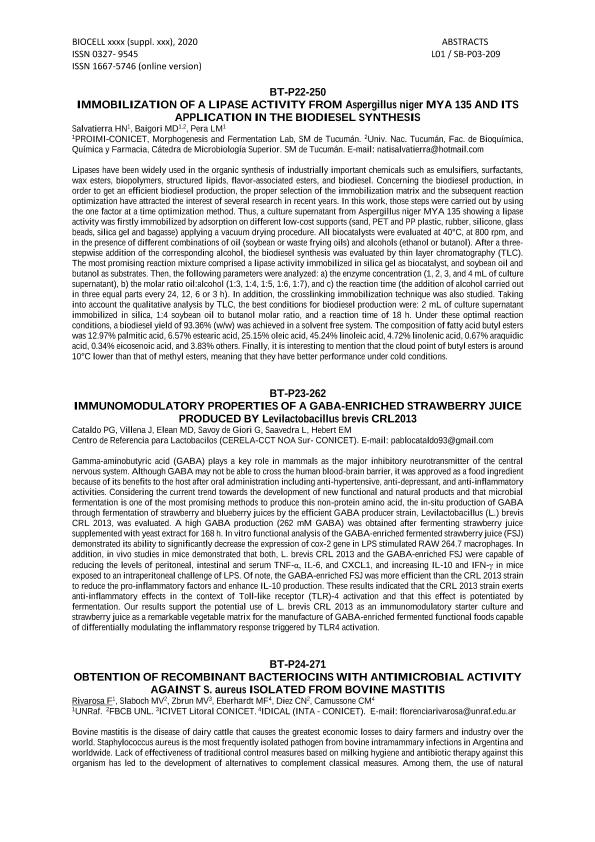Mostrar el registro sencillo del ítem
dc.contributor.author
Salvatierra, Hebe Natalia

dc.contributor.author
Baigori, Mario Domingo

dc.contributor.author
Pera, Licia Maria

dc.date.available
2022-12-15T13:55:30Z
dc.date.issued
2020
dc.identifier.citation
Immobilization of a lipase activity from Aspergillus niger MYA 135 and its application in the biodiesel synthesis; LVI Annual Meeting Argentine Society for Biochemistry and Molecular Biology and XV Annual Meeting Argentinean Society for General Microbiology; Ciudad Autónoma de Buenos Aires; Argentina; 2020; 1-1
dc.identifier.uri
http://hdl.handle.net/11336/181315
dc.description.abstract
Lipases have been widely used in the organic synthesis of industrially important chemicals such as emulsifiers, surfactants, wax esters, biopolymers, structured lipids, flavor-associated esters, and biodiesel. Concerning the biodiesel production, in order to get an efficient biodiesel production, the proper selection of the immobilization matrix and the subsequent reaction optimization have attracted the interest of several researches in recent years. In this work, those steps were carried out by using the one factor at a time optimization method. Thus, a culture supernatant from Aspergillus niger MYA 135 showing a lipase activity was firstly immobilized by adsorption on different low-cost supports (sand, PET and PP plastic, rubber, silicone, glass beads, silica gel and bagasse) applying a vacuum drying procedure. All biocatalysts were evaluated at 40 °C, at 800 rpm, and in the presence of different combinations of oil (soybean or waste frying oils) and alcohols (ethanol or butanol). After a three-stepwise addition of the corresponding alcohol, the biodiesel synthesis was evaluated by thin layer chromatography (TLC). The most promising reaction mixture comprised a lipase activity immobilized in silica gel as biocatalyst, and soybean oil and butanol as substrates. Then, the following parameters were analyzed: a) the enzyme concentration (1, 2, 3 and 4 ml of culture supernatant), b) the molar ratio oil:alcohol (1:3, 1:4, 1:5, 1:6, 1:7), and c) the reaction time (the addition of alcohol carried out in three equal parts every 24, 12, 6 or 3 h). In addition, the crosslinking immobilization technique was also studied. Taking into account the qualitative analysis by TLC, the best conditions for biodiesel production were: 2 ml of culture supernatant immobilized in silica, 1:4 soybean oil to butanol molar ratio, and a reaction time of 18 h. Under these optimal reaction conditions, a biodiesel yield of 93.36 % (w/w) was achieved in a solvent free system. The composition of fatty acid butyl esters was 12.97 % palmitic acid, 6.57 % estearic acid, 25.15 % oleic acid, 45.24 % linoleic acid, 4.72 % linolenic acid, 0.67 % araquidic acid, 0.34 % eicosenoic acid, and 3.83 others. Finally, it is interesting to mention that the cloud point of butyl esters is around 10 °C lower than that of methyl esters, meaning that they have better performance under cold conditions.
dc.format
application/pdf
dc.language.iso
eng
dc.publisher
Tech Science Press

dc.rights
info:eu-repo/semantics/openAccess
dc.rights.uri
https://creativecommons.org/licenses/by-nc-sa/2.5/ar/
dc.subject
ASPERGILLUS NIGER
dc.subject
LIPASE
dc.subject
IMMOBILIZATION
dc.subject
BIODIESEL
dc.subject.classification
Bioprocesamiento Tecnológico, Biocatálisis, Fermentación

dc.subject.classification
Biotecnología Industrial

dc.subject.classification
INGENIERÍAS Y TECNOLOGÍAS

dc.title
Immobilization of a lipase activity from Aspergillus niger MYA 135 and its application in the biodiesel synthesis
dc.type
info:eu-repo/semantics/publishedVersion
dc.type
info:eu-repo/semantics/conferenceObject
dc.type
info:ar-repo/semantics/documento de conferencia
dc.date.updated
2022-12-12T23:15:05Z
dc.identifier.eissn
1667-5746
dc.journal.pagination
1-1
dc.journal.pais
Argentina

dc.journal.ciudad
Ciudad Autónoma de Buenos Aires
dc.description.fil
Fil: Salvatierra, Hebe Natalia. Consejo Nacional de Investigaciones Científicas y Técnicas. Centro Científico Tecnológico Conicet - Tucumán. Planta Piloto de Procesos Industriales Microbiológicos; Argentina
dc.description.fil
Fil: Baigori, Mario Domingo. Consejo Nacional de Investigaciones Científicas y Técnicas. Centro Científico Tecnológico Conicet - Tucumán. Planta Piloto de Procesos Industriales Microbiológicos; Argentina
dc.description.fil
Fil: Pera, Licia Maria. Consejo Nacional de Investigaciones Científicas y Técnicas. Centro Científico Tecnológico Conicet - Tucumán. Planta Piloto de Procesos Industriales Microbiológicos; Argentina
dc.relation.alternativeid
info:eu-repo/semantics/altIdentifier/url/http://www.samige.org.ar/admin/news/files/170-TSP_BIOCELL_42376.pdf
dc.conicet.rol
Autor

dc.conicet.rol
Autor

dc.conicet.rol
Autor

dc.coverage
Internacional
dc.type.subtype
Reunión
dc.description.nombreEvento
LVI Annual Meeting Argentine Society for Biochemistry and Molecular Biology and XV Annual Meeting Argentinean Society for General Microbiology
dc.date.evento
2020-11
dc.description.ciudadEvento
Ciudad Autónoma de Buenos Aires
dc.description.paisEvento
Argentina

dc.type.publicacion
Journal
dc.description.institucionOrganizadora
Sociedad Argentina de Investigación Bioquímica y Biología Molecular
dc.description.institucionOrganizadora
Sociedad Argentina de Microbiología General
dc.source.revista
Biocell

dc.type
Reunión
Archivos asociados
